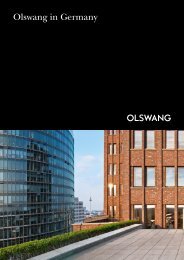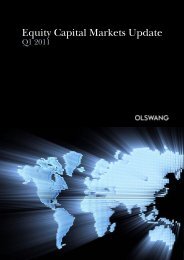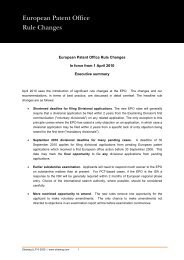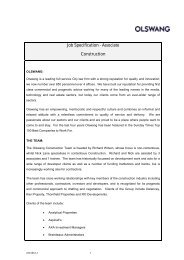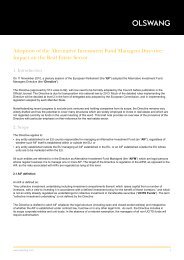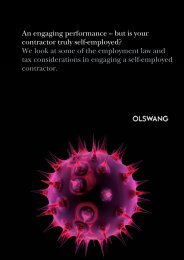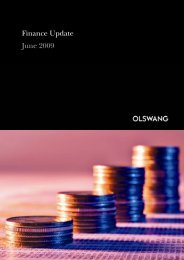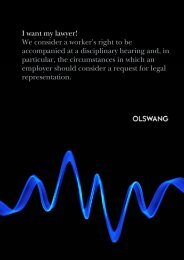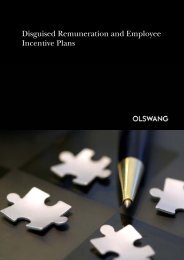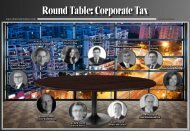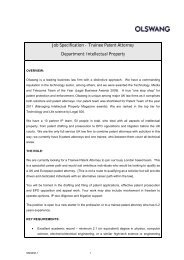Tax Advisor 2010 tax avoidance case law review - Olswang
Tax Advisor 2010 tax avoidance case law review - Olswang
Tax Advisor 2010 tax avoidance case law review - Olswang
Create successful ePaper yourself
Turn your PDF publications into a flip-book with our unique Google optimized e-Paper software.
<strong>Tax</strong> <strong>Advisor</strong><br />
<strong>2010</strong> <strong>tax</strong> <strong>avoidance</strong> <strong>case</strong> <strong>law</strong> <strong>review</strong><br />
Matthew Wentworth considers the key <strong>tax</strong> <strong>avoidance</strong> <strong>case</strong> <strong>law</strong><br />
developments of <strong>2010</strong>.<br />
Matthew Wentworth is a Barrister (Senior Associate) in the <strong>tax</strong> group at <strong>Olswang</strong> LLP. Matthew<br />
advises on a broad range of contentious and non-contentious matters, and has expertise in<br />
respect of both direct and indirect <strong>tax</strong>ation. Email: matthew.wentworth@olswang.com Tel: 0207<br />
067 3372.<br />
INTRODUCTION<br />
<strong>2010</strong> has been a year of consolidation. The courts have continued to explore the scope of the<br />
Ramsay (in direct <strong>tax</strong> <strong>case</strong>s) and Halifax (in VAT <strong>case</strong>s) principles.<br />
HM Revenue and Customs (“HMRC”) have not had been successful in all <strong>case</strong>s. Properly<br />
structured (and implemented) commercial arrangements can still succeed in mitigating <strong>tax</strong>. In<br />
general terms, the courts have shown a willingness to adopt a purposive approach to interpret<br />
coherent sets of <strong>tax</strong> rules, but a reluctance to fill the gaps in rules that lack such coherence.<br />
DIRECT TAXES<br />
PA Holdings v Revenue and Customs Commissioners [<strong>2010</strong>] STC 2343<br />
This <strong>case</strong> concerned whether the payment of dividends via a <strong>tax</strong> <strong>avoidance</strong> structure to<br />
employees should be <strong>tax</strong>ed as dividends (under the old Schedule F rules) or employment income<br />
(under the old Schedule E rules). The <strong>tax</strong>payer argued that the payments should be <strong>tax</strong>ed as<br />
dividends and so it should not be liable to any PAYE or national insurance contributions ("NICs")<br />
on the payments.<br />
The Upper Tribunal ("UT") has now confirmed the decision of the First Tier Tribunal (<strong>Tax</strong>) ("FTT")<br />
that:<br />
(i) The payments were both dividends and employment income. However, section 20(2)<br />
Income and Corporation <strong>Tax</strong>es Act 1988 (“ICTA”) provided that the distribution rules (in<br />
1
(ii)<br />
Schedule F) took precedence. Accordingly, the dividends could not be <strong>tax</strong>ed as<br />
employment income, and PAYE did not apply.<br />
The dividends were earnings for NICs purposes and, because there is no equivalent to<br />
section 20(2) ICTA in the NICs legislation, a NICs liability arose for the employer.<br />
The UT’s reasoning in relation to the Ramsay decision is of particular interest. The UT confirmed<br />
that Ramsay could apply to determine whether a payment was in fact an emolument, and<br />
therefore an amount of employment income, and so within the charge to <strong>tax</strong> in what is now<br />
Income <strong>Tax</strong> (Earnings and Pensions) Act 2003 ("ITEPA"). This makes sense; Ramsay has<br />
frequently been applied to determine whether a profit or loss really exists from a commercial<br />
perspective, and hence there is no logical reason why it should not apply to determine whether a<br />
payment, viewed realistically, is an amount of employment income, given that an “emolument” is<br />
also a commercial concept.<br />
However, the UT decided that the application of Ramsay could not exclude the dividend from the<br />
distribution rules; the payment was clearly in fact a dividend, and so it was not possible to<br />
interpret the distribution rules in a way which prevented them from applying here. Therefore the<br />
<strong>tax</strong>payer could rely on section 20(2) ICTA for the proposition that the payment could not be <strong>tax</strong>ed<br />
as employment income. HMRC have sought permission to appeal this decision.<br />
UBS AG v Revenue and Customs Commissioners [<strong>2010</strong>] UKFTT 366 (TC)<br />
UBS established a scheme to incentivise employees through paying them bonuses in the form of<br />
restricted securities. The intention was to avoid any income <strong>tax</strong> or NICs on the payment, relying<br />
on the detailed provisions of section 425 and 429 ITEPA, as in force at the time of the scheme<br />
(subsequent legislative amendments have removed the possibility of implementing similar <strong>tax</strong><br />
planning). The shares could, on the face of it, be forfeited for 90% of their market value, although<br />
additional option arrangements ensured that the actual amount of exposure faced by the<br />
employees was minimal.<br />
The FTT first decided that the securities issued were not "restricted securities", as defined in<br />
section 423 ITEPA. It seems that the Tribunal considered that the existence of the option<br />
arrangements meant the forfeiture provisions did not reduce the market value of the shares.<br />
More interestingly, the Tribunal commented obiter that, if it was wrong on this point, the scheme<br />
as a whole was a preordained structure designed to deliver a <strong>tax</strong> efficient bonus to employees.<br />
Thus, Ramsay, the arrangements should be viewed realistically and so the cash that the<br />
employees received should be <strong>tax</strong>ed as an emolument.<br />
This decision has a potentially wide impact, especially in relation to employee incentivisation<br />
structures. Viewed realistically, any such structure could be said to have the intention to deliver<br />
2
earnings to employees in a <strong>tax</strong> efficient manner. It is surprising that the FTT decided that the<br />
Ramsay doctrine can apply in relation to the interpretation of highly prescribed technical code<br />
such as that contained in Part 7 ITEPA.<br />
Peter Schofield v Revenue and Customs Commissioners [<strong>2010</strong>] UKFTT 196 (TC)<br />
This decision concerned a complicated structure for the artificial creation of a capital loss<br />
involving four interlinked options. Viewing each option in isolation, a significant capital loss was<br />
made on the "closing out" of the first option, whilst a significant capital gain was made on the<br />
"closing out" of the third option. The <strong>tax</strong>payer argued that the capital loss on the first option was<br />
<strong>tax</strong> deductible whilst the capital gain on the third option was exempt from charge because it was<br />
an option over gilt-edged securities.<br />
The FTT had little difficulty in finding that the four options needed to be viewed as a single<br />
composite transaction under which no actual loss had arisen. The scheme had built in the<br />
possibility that, due to fluctuations in the FTSE 100, the scheme would only realise a small profit<br />
or a small loss, but this was not enough to stop Ramsay applying.<br />
This would appear to be a straightforward application of the House of Lords decision in Scottish<br />
Provident Institution v Revenue and Customs Commissioners [2005] STC 15; interlinked financial<br />
instruments should be viewed as a single transaction for the purposes of determining whether a<br />
loss has arisen, and the artificially inserted slim possibility of the scheme not working as planned<br />
can be ignored. Following the Court of Appeal’s restatement of this principle last year in Astall v<br />
Revenue and Customs Commissioners [<strong>2010</strong>] STC 137 this decision appeared inevitable.<br />
Andrew Berry v Revenue and Customs Commissioners [2009] UKFTT 386 (TC)<br />
This decision concerned gilt strip planning, which was a popular way of artificially creating an<br />
income loss through the acquisition of a gilt strip and the granting of an option over the gilt strip to<br />
a third party. The planning relied on creating a loss under paragraph 14A of Schedule 13 Finance<br />
Act 1996. To succeed the <strong>tax</strong>payer had to show that the scheme was not self-cancelling, in the<br />
sense that there was a realistic possibility that the option would not be exercised and Mr Berry<br />
would be left owning the gilt strips. To this end the scheme had built in to it a possibility (agreed<br />
by the parties as being 7%) that the option would not be exercised, such that Mr Berry was left<br />
owning the gilt strips.<br />
Unsurprisingly, the FTT applied Astall. The tribunal held that the possibility of the option not being<br />
exercised was part of the scheme, the parties proceeded on the basis that this possibility could<br />
be ignored, and so the possibility should be ignored in applying the legislation. In essence, this<br />
was a self-cancelling scheme in which Mr Berry never really owned the gilt strips and therefore<br />
3
never realised a commercial loss for the purposes of paragraph 14A. The decision is being<br />
appealed to the UT.<br />
VAT<br />
GMAC UK Plc v Revenue and Customs Commissioners [<strong>2010</strong>] UKFTT 202 (TC)<br />
The decision in GMAC UK Plc is interesting in that it did not involve <strong>tax</strong> <strong>avoidance</strong>, yet HMRC<br />
stilltried to apply the Halifax decision. GMAC bought cars and resold them under hire purchase<br />
agreements. GMAC would repossess the cars of defaulting customers and resell them. At the<br />
relevant time this resale was not a supply for VAT purposes. GMAC made claims for bad debt<br />
relief in connection with the sale of cars to defaulting customers in relation to periods before 1997<br />
on the basis that UK <strong>law</strong> (as it then stood) was incompatible with the VAT Directive, in that it<br />
required the customer to be insolvent and property in the goods had to have passed to the<br />
customer in order for the supplier to claim bad debt relief.<br />
GMAC successfully argued that the UK <strong>law</strong> as it stood before 1997 was incompatible with the<br />
VAT Directive such that, on the face of it, it should be entitled to make bad debt claims. However,<br />
HMRC argued that, where GMAC bought a car, resold it under a hire purchase agreement, then<br />
repossessed it and sold it again, the transactions should be redefined, following Halifax, as a<br />
single supply to the final customer, with output <strong>tax</strong> being due on this supply. Otherwise, GMAC<br />
would be at a competitive advantage as compared with other car dealers, which would distort<br />
fiscal neutrality.<br />
The FTT rejected HMRC’s argument and allowed the <strong>tax</strong>payer’s appeal. Halifax could not apply<br />
outside the context of a <strong>tax</strong> <strong>avoidance</strong> scheme. This conclusion is a sensible one and restricts the<br />
role of Halifax to policing the "wild west" of VAT <strong>avoidance</strong> (which was clearly the intention of the<br />
ECJ).<br />
Paul Newey T/A Ocean Finance v Revenue and Customs Commissioners [<strong>2010</strong>] UKFTT 183<br />
In this <strong>case</strong> the FTT had to consider how Halifax would apply where a <strong>tax</strong>payer had migrated his<br />
loan broking business to Jersey. The clear intention of the reorganisation was that irrecoverable<br />
VAT on advertising costs would be avoided, because the advertising services would be supplied<br />
to the new Jersey entity (Alabaster) in Jersey, and so would be outside the scope of VAT.<br />
HMRC argued that, applying Halifax, the <strong>tax</strong>payer should be seen as still supplying the loan<br />
broker services, and so the advertising services should be viewed as supplied to him. However,<br />
4
the FTT determined that, as a question of fact, Alabaster was a genuine commercial entity which<br />
was not simply "rubber stamping" decisions of the <strong>tax</strong>payer; it was carrying out the business of<br />
loan broking itself.<br />
In light of these determinations of fact the FTT held that Halifax could not apply to recharacterise<br />
the transactions in terms of the entity supplying the loan broking services so that the recipient of<br />
the advertising services changed. This was a wholesale reorganisation of the business, which it<br />
was legitimate for the <strong>tax</strong>payer to undertake, and was not contrary to the purpose of the VAT<br />
Directive. The fact that the essential aim of the reorganisation was to ensure that a VAT saving<br />
was achieved did not alter this conclusion. The <strong>tax</strong>payer’s appeal therefore succeeded. HMRC<br />
are appealing the decision to the UT.<br />
Moorbury Limited v Revenue and Customs Commissioners [2020] UKUT 360 (TCC)<br />
The <strong>tax</strong>payer in this <strong>case</strong> accepted that Halifax could apply where it had implemented a scheme<br />
to try to ensure that the VAT costs on the development of a piece of land could be recovered in<br />
circumstances where the <strong>tax</strong>payer would itself not be able to recover this VAT, because it was<br />
making exempt supplies of land.<br />
However, the <strong>tax</strong>payer argued that, because the transactions were redefined in accordance with<br />
Halifax, it had wrongly accounted for output <strong>tax</strong> as part of the scheme. HMRC argued that to<br />
recover this output <strong>tax</strong> the <strong>tax</strong>payer had to make a claim under section 80 VAT Act 1994, which<br />
the <strong>tax</strong>payer was out of time to do. The UT allowed the <strong>tax</strong>payer’s appeal, finding that the<br />
consequence of a Halifax redefinition was that the <strong>tax</strong>payer was automatically entitled to recover<br />
any output <strong>tax</strong> it had accounted for which was no longer due under the redefined transaction.<br />
This conclusion is a sensible one and ensures that Halifax applies in an even-handed way as<br />
between <strong>tax</strong>payer and HMRC.<br />
Weald Leasing v Revenue and Customs Commissioners (Case C-103/09) (Opinion of A-G<br />
Mazak)<br />
The Advocate General delivered his long awaited opinion in this <strong>case</strong> On 26 October <strong>2010</strong>. The<br />
<strong>tax</strong>payer had put in place a structure to try to defer irrecoverable VAT by acquiring goods into one<br />
company, which leased them at less than market value to an unconnected third party, which then<br />
leased them on to a member of the same group (but not VAT group) as the first company, making<br />
a small profit. The intention of the structure was to allow the recovery of VAT on the supply of the<br />
goods, with irrecoverable VAT accruing on the lease of the goods to the second group company.<br />
The interposition of the third party was to ensure that a market value rent under the lease to the<br />
second company could not be directed by HMRC under Schedule 6 VAT Act 1994.<br />
5
The Advocate General agreed with the <strong>tax</strong>payer that it was free to decide whether to purchase or<br />
lease goods, even where its reason for doing so was to reduce irrecoverable VAT. This was not<br />
contrary to the VAT Directive. However, the Advocate General decided that it was an abusive<br />
practice for a <strong>tax</strong>payer to interpose an unconnected company in a series of leases in order to<br />
prevent a direction that the lease should be treated for VAT purposes as having a market value<br />
rent. The redefinition which was needed to remedy this abuse was to ignore the third party and<br />
impute a market value lease between the two connected companies.<br />
If the ECJ agrees with the Advocate General then this will be a victory in part for both HMRC and<br />
the <strong>tax</strong>payer. The reasoning of the Advocate General is highly persuasive. <strong>Tax</strong>payers should be<br />
free to choose the form of transactions they undertake, but wholly artificial elements included in<br />
those transactions to achieve a VAT saving are abusive.<br />
CONCLUSIONS<br />
<strong>2010</strong> has seen the courts developing and refining the Ramsay principle. The courts continue to<br />
be hostile to artificial schemes, and appear unlikely to accept any scheme in which a <strong>tax</strong>payer<br />
seeks to create a loss artificially where it has not made an economic loss. <strong>Tax</strong>payers cannot<br />
escape this conclusion by artificially including within the scheme a slim possibility that the scheme<br />
will not proceed as planned.<br />
The limitations of Halifax have also been explored, and both HMRC and the <strong>tax</strong>payer have had<br />
successes. <strong>Tax</strong>payers cannot implement wholly artificial schemes without them being redefined,<br />
but that redefinition cannot work only in HMRC’s favour. Equally, if <strong>tax</strong>payers make commercial<br />
decisions to operate their business in a different manner, and accept the commercial<br />
consequences of those decisions, then Halifax should not come into play, even where these<br />
commercial decisions are motivated by the VAT savings which will be achieved.<br />
2011 is shaping up to be a bumper year for <strong>tax</strong> <strong>avoidance</strong> <strong>case</strong>s. We await the decision of the<br />
Supreme Court in DCC Holdings v Revenue and Customs Commissioners [<strong>2010</strong>] STC 80 with<br />
interest. It should help clarify whether a purposive interpretation of legislation can be adopted<br />
even where the legislation in question contains complex and precisely detailed rules on how repo<br />
transactions should be <strong>tax</strong>ed. The Court of Appeal in Mayes v Revenue and Customs<br />
Commissioners [<strong>2010</strong>] STC 1 will consider a similar question: can you apply a purposive<br />
interpretation to part of a piece of legislation for which no discernable overarching purpose can be<br />
determined? Finally, in the Tower MCashback LLP1 v Revenue and Customs Commissioners<br />
[<strong>2010</strong>] STC 809 <strong>case</strong>, the Supreme Court (sitting as a panel of seven) will revisit its decision in<br />
BMBF v Mawson [2005] STC 1 to consider in what circumstances a <strong>tax</strong>payer can argue it has<br />
made a “payment” for capital allowances purposes, when the monies used in making the<br />
payment appear to go round in a circle, beginning and ending with the same party.<br />
6




